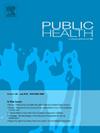中国东部非吸烟孕妇二手烟暴露与母亲抑郁的纵向关系:一项前瞻性出生队列研究
IF 3.9
3区 医学
Q1 PUBLIC, ENVIRONMENTAL & OCCUPATIONAL HEALTH
引用次数: 0
摘要
目的:妊娠期暴露于二手烟(SHS)较为普遍,并可能对孕产妇心理健康产生负面影响。最近关于怀孕期间接触二手烟和抑郁之间关系的证据仍然不一致。本研究旨在探讨SHS暴露与母亲抑郁之间的纵向关系。研究设计一项前瞻性出生队列研究。方法2017年10月至2021年9月,我们开展了一项包括5311名孕妇的前瞻性出生队列研究。我们使用混合效应模型和基于组的多变量轨迹模型来估计妊娠期间SHS暴露与抑郁之间的纵向关联。结果妊娠早期、中期和晚期抑郁患病率分别为40.61%、19.00%和20.35%;50.52%的妇女在怀孕期间暴露于SHS。与未暴露于SHS的妇女相比,暴露于SHS的妇女在妊娠早期(OR: 1.34, 95% CI: 1.19-1.51)、妊娠中期(OR: 1.70, 95% CI: 1.45-1.98)和妊娠晚期(OR: 1.71, 95% CI: 1.47-1.99)患抑郁症的几率更高。妊娠1、2、3个月暴露显示出逐渐增强的相关性(or分别为1.37、1.89、2.08)。SHS暴露与抑郁轨迹增加相关(OR: 1.38, 95% CI: 1.05-1.81)。在怀孕期间睡眠质量良好的失业母亲中,SHS和抑郁症之间的联系更为明显。结论妊娠期暴露于SHS对当前及以后的抑郁均有影响。解决二手烟暴露问题对于促进精神健康和改善母亲和后代的健康结果至关重要。本文章由计算机程序翻译,如有差异,请以英文原文为准。
The longitudinal association between second-hand smoke exposure and maternal depression among non-smoking pregnant women in East China: A prospective birth cohort study
Objectives
Second-hand smoke (SHS) exposure during pregnancy is common and may negatively impact maternal mental health. Recent evidence on the association between SHS exposure and depression during pregnancy remains inconsistent. This study aims to examine the longitudinal association between SHS exposure and maternal depression.
Study design
A prospective birth cohort study.
Methods
From October 2017 to September 2021, we conducted a prospective birth cohort study including 5311 pregnant women. We applied mixed-effects models and group-based multivariate trajectory modeling to estimate the longitudinal association between SHS exposure and depression during pregnancy.
Results
The prevalence of depression during pregnancy was 40.61 %, 19.00 %, and 20.35 % in the first, second, and third trimesters, respectively; 50.52 % of the women were exposed to SHS during pregnancy. Compared to unexposed women, those with SHS exposure had higher odds of depression in the first (OR: 1.34, 95 % CI: 1.19–1.51), second (OR: 1.70, 95 % CI: 1.45–1.98), and third trimesters (OR: 1.71, 95 % CI: 1.47–1.99). Exposure in one, two, or three trimesters showed progressively stronger associations (ORs: 1.37, 1.89, 2.08, respectively). SHS exposure was associated with an increased trajectory of depression (OR: 1.38, 95 % CI: 1.05–1.81). The association between SHS and depression was more pronounced among unemployed mothers who had good sleep quality during pregnancy.
Conclusions
Exposure to SHS during pregnancy affects current and subsequent depression. Addressing SHS exposure is essential to promote mental health and improve the health outcomes of mothers and offspring.
求助全文
通过发布文献求助,成功后即可免费获取论文全文。
去求助
来源期刊

Public Health
医学-公共卫生、环境卫生与职业卫生
CiteScore
7.60
自引率
0.00%
发文量
280
审稿时长
37 days
期刊介绍:
Public Health is an international, multidisciplinary peer-reviewed journal. It publishes original papers, reviews and short reports on all aspects of the science, philosophy, and practice of public health.
 求助内容:
求助内容: 应助结果提醒方式:
应助结果提醒方式:


